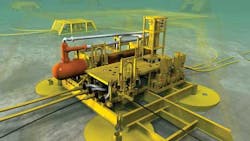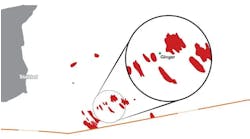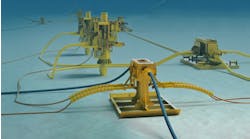Qualification tests support reliability, fitness of design
Rob Perry
FMC Technologies
Subsea processing consists of a range of technologies for separation, pumping, and compression that enable production from offshore wells without the need for surface facilities. Seabed processing systems have become increasingly accepted by operators as a solution to accelerate reserves, maximize production, and reduce costs. Today, more than 20 subsea boosting systems and six subsea separation systems have been installed or awarded throughout the world, demonstrating these systems can reliably deliver the value promised. Given the growing number of greenfield and brownfield applications, some analysts anticipate the number of subsea processing systems installed globally could double by 2020.
The value promise
For low energy reservoirs or reservoirs with poor rock or fluid properties, multiphase boosting or the combination of gas/liquid separation and liquid boosting have enabled recovery of otherwise stranded oil. Separating gas from liquids offers the benefits of mature multi-phase boosting options, but allows even lower wellhead pressures. A very low wellhead pressure enables gas lift in the well, while having a separate gas line allows high efficiency pumping, minimizes flow assurance risks, and increases tieback distances. These applications can enable field developments by increasing recovery of reserves and accelerating production to improve field development economics. Examples of low energy field applications include Statoil's Tordis (yielding an increase of over 3% or 19 MMbbl of original oil in place) and Shell's Perdido and Parque das Conchas (BC-10).
Later life reservoirs with high water cut that produce into constrained topsides facilities benefit from subsea water separation and boosting. More oil can be produced through facilities otherwise choked by water as backpressure on the reservoir is reduced to increase production. Examples of such field applications include Statoil's Tordis where separated water was injected into a disposal well. Despite initial challenges with the injection well, the Tordis separator system functions as designed with availability approaching 100%. Most recently in Brazil's Campos basin, Petrobras' Marlim subsea processing system was installed to enable the separated water stream to be further cleaned to allow reinjection into the producing reservoir. This can increase pressure support and sweep to extend Marlim's productive life and to maximize ultimate oil recovery.
In even later field life, subsea processing can allow for an entire topside facility to be decommissioned and the processed fluids to be tied back to a new, more distant, host. This type of application reduces costs and increases both overall facility integrity and recoverable reserves.
An example of this approach is Petrobras' Congro and Corvina project which is currently being executed in Brazil. Subsea processing will enhance Petrobras' revenues and return on investment by extending the life of these mature fields and increasing ultimate oil recovery. In cases when there are limitations on the host availability due to lease terms or facility integrity, or when operating costs rise, subsea processing can accelerate production and increase recovery beyond the existing natural production levels.
Overcoming adoption challenges
Critical factors in the adoption of any new oilfield technology are availability and reliability when it comes to delivering the promised financial value. A number of complex subsea separation projects have been commissioned fault free and have demonstrated an availability exceeding that of conventional topside projects. This can only be achieved using a disciplined, multi-faceted approach based on reliability engineering in design, extensive qualification testing, and strategies to minimize risk.
Perhaps the most critical element is employing a disciplined reliability strategy throughout the design phase. Using techniques such as Reliability, Availability and Maintainability (RAM) analysis, and Failure Mode Effect and Criticality Analysis (FMECA) provide vital insight to inform front-end engineering and detailed system design. While the RAM analysis is typically used to predict system performance and provide a basis for system optimization, the FMECA identifies relevant subsystems and failure modes. Although these methods are useful to model and predict failures, the reliability strategy also should ensure the system includes appropriate data capture, storage, and management to bring operations data into a formal, lessons-learned program. Both operators and subsea system vendors can benefit from the analysis of field data as lessons learned can be applied to improve availability and performance of subsea processing systems.
Another important element of subsea processing is qualification testing. An extensive qualification program can help evaluate the functional, environmental, and reliability performance of the system.
A detailed risk-based program will help determine if the technology can perform within the pre-set requirements, and in accordance to the design models established. Before installation, extensive qualification testing on several process systems, including Tordis and Marlim, was performed. This testing was valuable for the operability of these systems in their various subsea environments. Similar testing will also be performed on Petrobras' Congro and Corvina project.
To reduce the risk of working with new technologies, FMC Technologies worked with most operators on qualification programs to test and evaluate technology well in advance of the upcoming projects.
Coupled with a disciplined reliability strategy and extensive qualification testing, several other information-based methods reduce the risk of implementing subsea processing. An integrity management program that incorporates monitoring, testing, and inspection can capture data for risk analysis. This information can be used for integrity monitoring. For example, wall thickness estimations can be deduced from pressure measurements, compositions, and velocity. Another use for the software is monitoring component health where specific sensors and algorithms can be used to estimate time to failure of a component with single-mode failure. Decision support software can be used to process data, model forward behavior, and train personnel on the recommended operation of equipment.
In evaluating any technology, whether proven or new, investment rewards and risks must be carefully calculated. Subsea processing systems now are reliable solutions deployed in a range of applications in both brownfield and greenfield developments. Today, a number of methods and techniques are in use to ensure availability of subsea processing systems meet or exceed operator expectations. As subsea processing technologies continue to prove their value, their use will continue to grow. In the future, full subsea processing could be possible, thereby eliminating the need for surface facilities.
Offshore Articles Archives
View Oil and Gas Articles on PennEnergy.com





